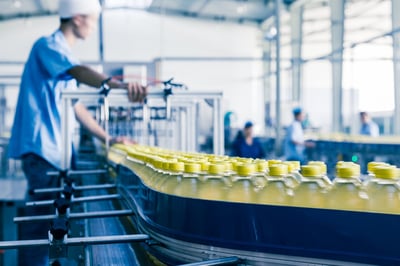Essential Safety Tips to Protect Workers on the Manufacturing Floor
 According to the U.S. Bureau of Labor Statistics, there are about three million non-fatal workplace injuries and illnesses reported every year. That equates to about 3.2 cases for every 100 full-time employees, many of which occur in manufacturing settings where the climate is just right for slip and fall accidents, back injuries, head and other injuries sustained from falling objects, and other such hazards.
According to the U.S. Bureau of Labor Statistics, there are about three million non-fatal workplace injuries and illnesses reported every year. That equates to about 3.2 cases for every 100 full-time employees, many of which occur in manufacturing settings where the climate is just right for slip and fall accidents, back injuries, head and other injuries sustained from falling objects, and other such hazards.
In addition to the fact that you truly care about your workers and consider them friends, or even family, those accidents rack up substantial costs. Productivity is lost, the worker has to be replaced (at least temporarily), and the costs of your workers' comp insurance goes up. Often, an accident means a visit from OSHA, plus the costs of any recommendations they make or fines they levy. All this assumes the worker doesn't sue, which can mean many more dollars for legal fees, punitive damages, and any compensation the court awards them.
For the overwhelming majority of manufacturers, it's much easier and better to simply put the right safety measures in place ahead of time.
Here are the best tips for keeping worker injuries at the absolute minimum.
It Starts at the Ground Level
Floors are responsible for far more than their share of accidents. Here are the best tips for keeping workers safe on your floors:
- Make sure the flooring materials are the best recommended for the environment. Different floors are more suitable for wet, cold, or greasy situations, etc.
- Make sure floors are in good repair. Damaged flooring can cause slips, trips, and falls.
- Use mats judiciously. While mats can keep water or grease contained in an area, these can also become trip and fall hazards.
- Use anti-slip surfaces wherever needed.
- Clearly mark any obstacles like steps, sloping floors, or areas that tend to become slick or dangerous.
- Keep clutter at bay! All workers should understand that it's within their responsibilities to keep clutter to a minimum in order to make everyone safer.
Preventing Fire Incidents
Fires are potentially much more harmful than slip and fall accidents, but fortunately, they aren't as common. Knowing how to prevent fires helps keep your workers, as well as your facilities and inventory, safe from fire or explosion. Here's how:
- Only keep the materials needed immediately in a given area to reduce the chances of combustion.
- Keep dust cleaned away to reduce the chances of explosion.
- Insist that workers clean their clothing if it becomes soiled with flammable substances.
- Impose strict penalties for workers who don't utilize safety gear and protocols.
- Make sure all areas are equipped with fire extinguishers that are rated for the materials and substances in use in that area.
Plan for the Best, Prepare for the Worst
Even when you've done everything you can, humans are humans, and accidents will happen. That's why the best safeguard is to have a panic alarm system installed and assure that it's operable at all times. These panic alarm systems are designed to be activated with a simple press of a button, so that help can be dispatched quickly. It delivers all of the relevant information to responders, including the location of the incident. Features like man-down alarms and no-response alerts assure that your workers can get the help they need, even if they aren't able to send for help.
To see how a panic alarm system can benefit the workers on your manufacturing floor, request a quote today.
About Tony Ridzyowski
Tony Ridzyowski leads the Inside Sales Team at Turn-key Technologies, Inc., where he also supports marketing, partner strategy, training, and CRM operations. Since joining TTI in 2014, Tony has earned top producer honors and President’s Club recognition. With a background in network cabling and experience working with Fortune 500 clients like Wells Fargo and Countrywide Home Loans, Tony brings decades of industry insight to every customer conversation.





